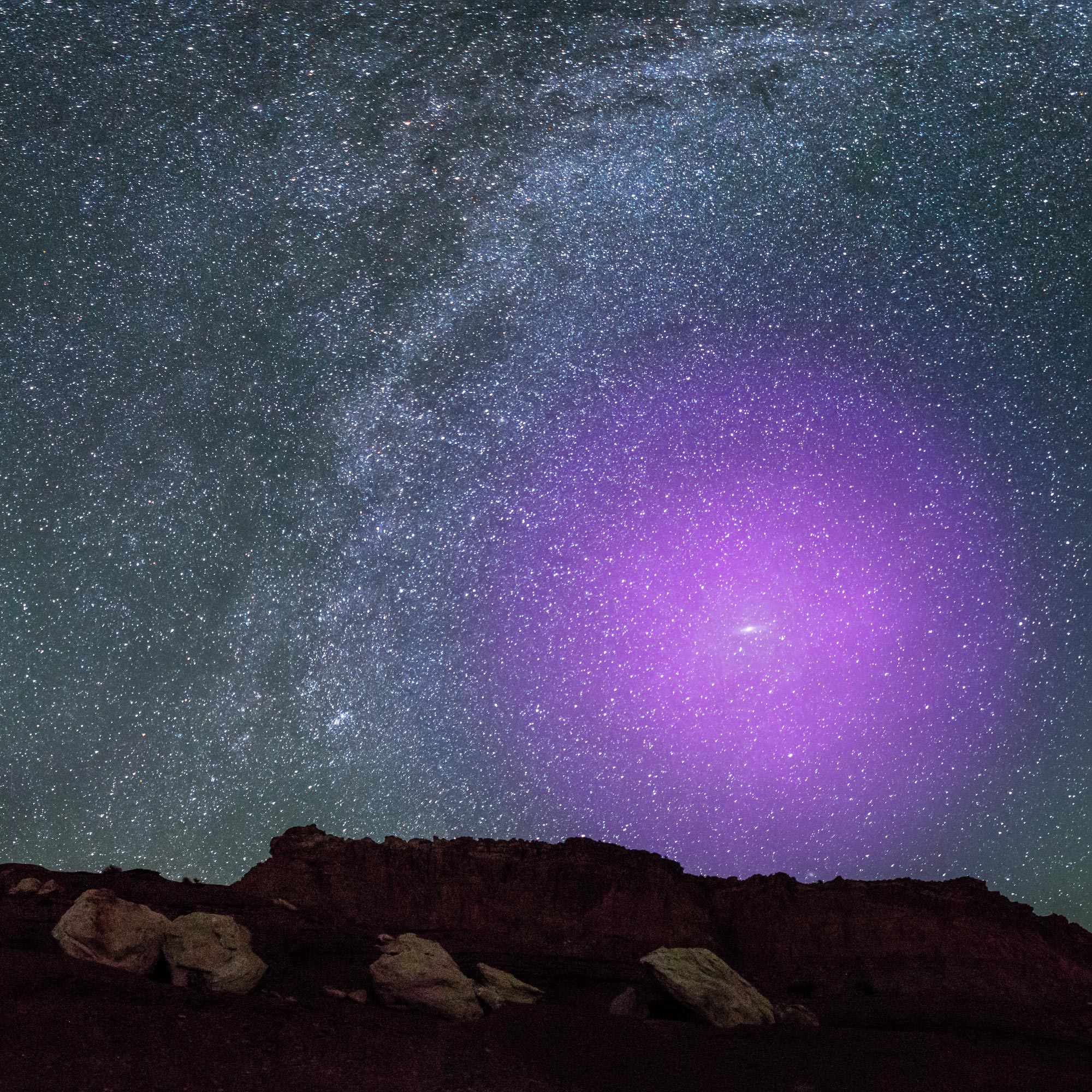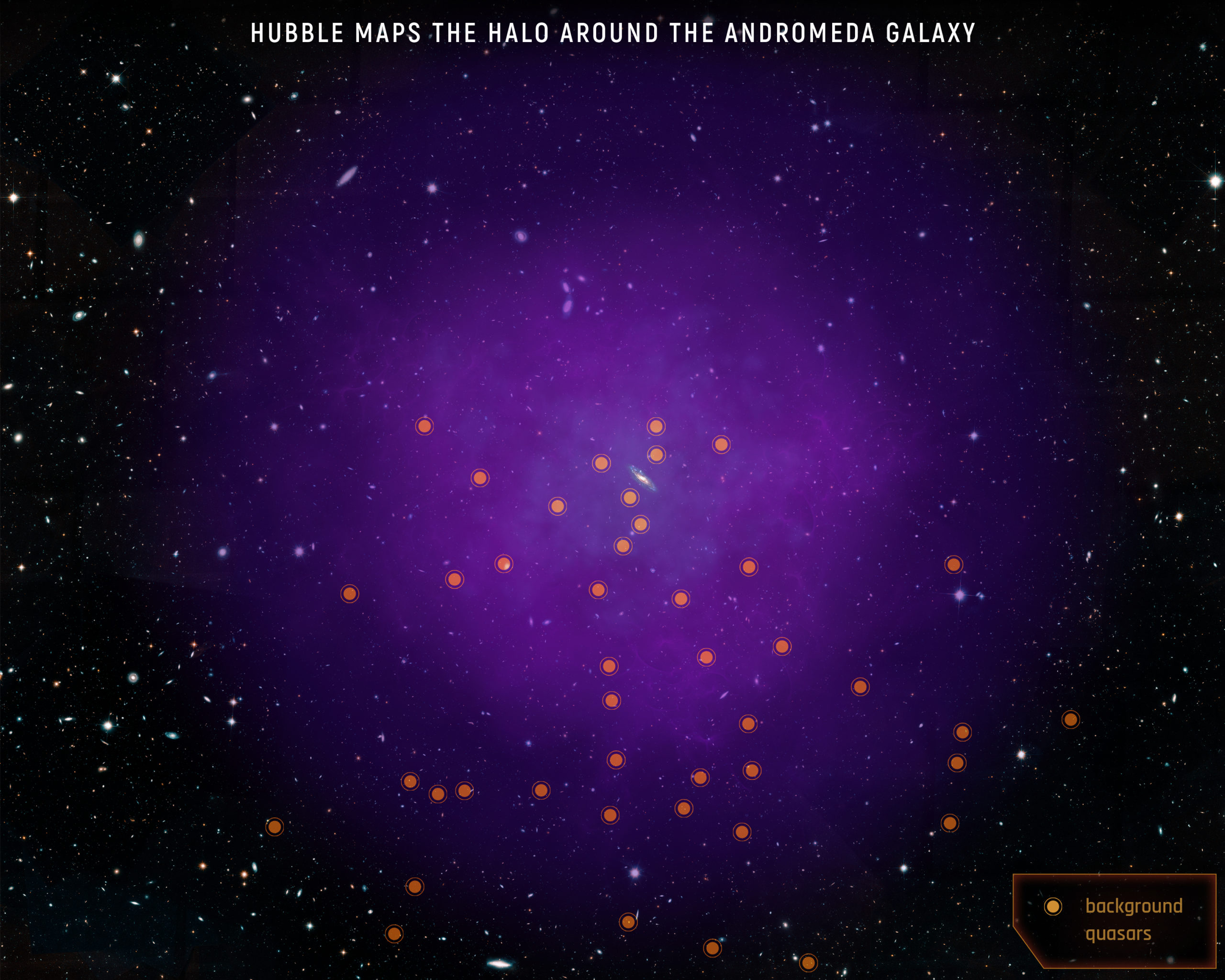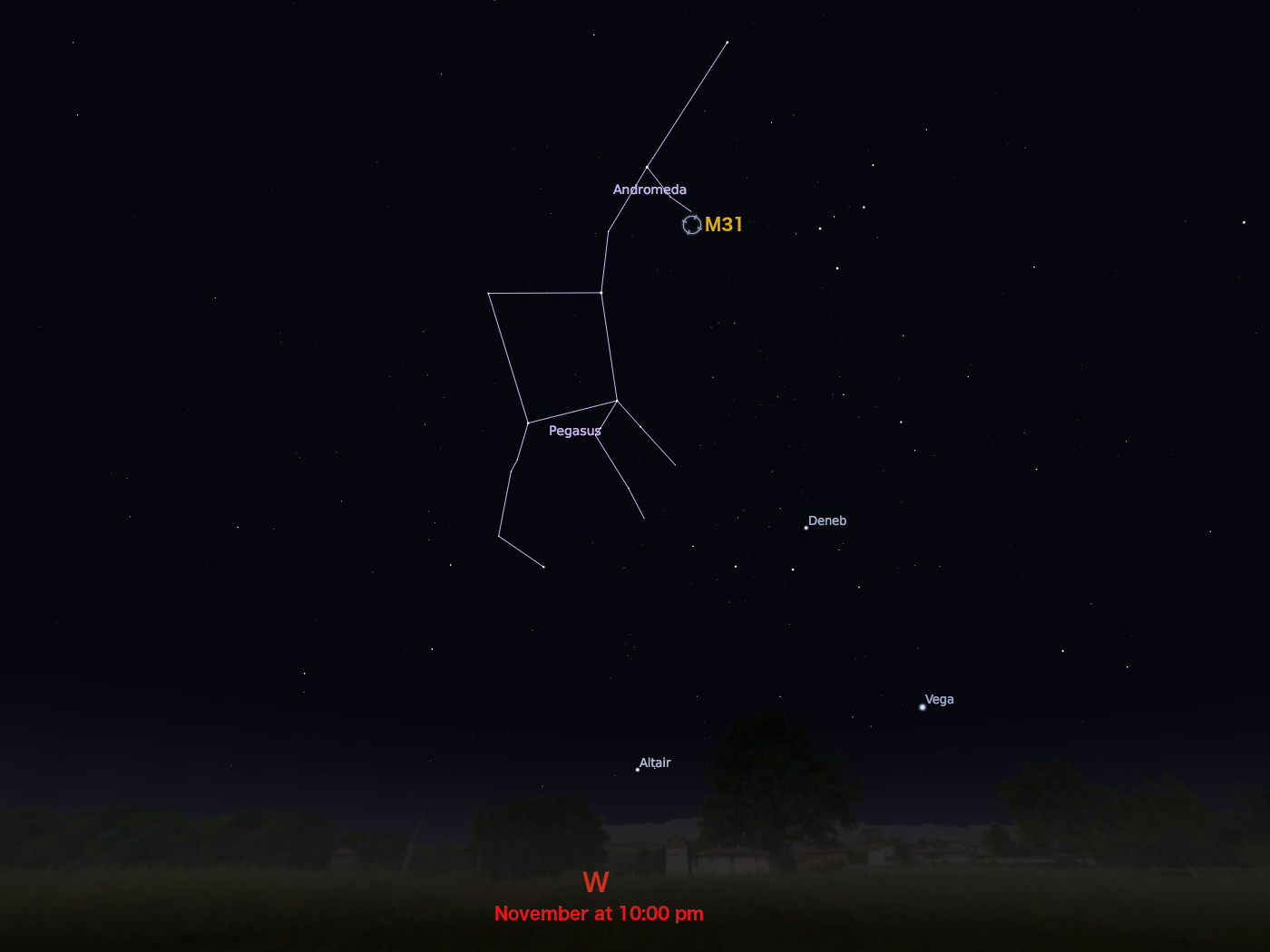What is known about the Andromeda galaxy?
The Andromeda Galaxy, also known as M31, is a
What did the scientists find out?
In a landmark study, scientists usingThe Hubble Space Telescope has mapped the immense envelope of gas - the halo - that surrounds the Andromeda galaxy. Scientists were surprised to find that this thin, almost invisible halo of diffuse plasma extends 1.3 million light years from the galaxy - about halfway to our Milky Way - and 2 million light years in some directions. This means that Andromeda's halo is already bumping into our galaxy's halo.
They also found that the halo has a layeredstructure with two main nested and separate gas shells. This is the most comprehensive study of the halo surrounding the galaxy. The closer the observed Andromeda halo is, the better we can understand its structure.
 This illustration shows a gas haloAndromeda galaxy, if it could be seen with the naked eye. At 2.5 million light-years away, the majestic spiral galaxy of Andromeda is so close to us that it appears as a cigar-shaped patch of light high in the autumn sky. If its gaseous halo could be seen with the naked eye, it would be about three times as wide as Ursa Major—by far the largest feature in the night sky.
This illustration shows a gas haloAndromeda galaxy, if it could be seen with the naked eye. At 2.5 million light-years away, the majestic spiral galaxy of Andromeda is so close to us that it appears as a cigar-shaped patch of light high in the autumn sky. If its gaseous halo could be seen with the naked eye, it would be about three times as wide as Ursa Major—by far the largest feature in the night sky.
Image Credit & Copyright: NASA, ESA, J. DePaskuel & E. Wheatley (STScI) & Z. Levy (background image)
“Understanding the huge gas halos surroundingthe galaxy is extremely important, '' explained co-investigator Samantha Berek of Yale University in New Haven, Connecticut. “This reservoir of gas contains fuel for future star formation in the galaxy, as well as remnants from events such as supernovae. It is full of clues to the past and future evolution of the galaxy, and we can finally study it in full detail on our closest galactic neighbor. "
“We found that the inner shell,spanning about half a million light-years, it is much more complex and dynamic, ”explained study leader Nicholas Lehner of the University of Notre Dame in Indiana. - The outer shell is smoother and hotter. This difference is likely the result of the impact of supernova activity in the disk of the galaxy, more directly affecting the inner halo. "
A sign of this activity is the discoveryteam of a large number of heavy elements in the Andromeda gas halo. The heavier elements are prepared in the bowels of stars and then ejected into space - sometimes violently when the star dies. The halo is then contaminated with this material from stellar explosions.
The AMIGA project and the search for quasars
As part of a program called Project AMIGA(Map of Ionized Gas Absorption in Andromeda) The study examined the light of 43 quasars—the very distant, brilliant cores of active galaxies powered by black holes—located far beyond Andromeda. Quasars are among the brightest cosmic objects in the Universe, representing the nuclei of galaxies located far beyond Andromeda. Quasars scattered behind the halo “illuminate” it, which allows scientists to study these areas in detail.
Looking through the halo at the light of quasars, the teamobserved how this light is absorbed by the Andromeda halo and how this absorption varies in different regions. Andromeda's huge halo is made of a very rarefied and ionized gas that does not emit easily detectable radiation. Therefore, tracking the absorption of light from a background source is the best way to investigate this material.
 This illustration shows location 43quasars, which scientists used to study the Andromeda gas halo. These quasars - the very distant, brilliant nuclei of active galaxies fueled by black holes - are scattered far beyond the halo, allowing scientists to explore multiple regions. Looking through the huge halo at the light of the quasars, the team observed how this light is absorbed by the halo and how this absorption changes in different regions. By tracking the absorption of light from background quasars, scientists can investigate the halo material.
This illustration shows location 43quasars, which scientists used to study the Andromeda gas halo. These quasars - the very distant, brilliant nuclei of active galaxies fueled by black holes - are scattered far beyond the halo, allowing scientists to explore multiple regions. Looking through the huge halo at the light of the quasars, the team observed how this light is absorbed by the halo and how this absorption changes in different regions. By tracking the absorption of light from background quasars, scientists can investigate the halo material.
Sources: NASA, ESA and E. Wheatley (STScI)
Researchers used a unique opportunitythe Hubble Space-Origin Spectrograph (COS) to study ultraviolet light from quasars. Ultraviolet light is absorbed by the Earth's atmosphere, making it impossible to observe with ground-based telescopes. The team used COS to detect ionized gases from carbon, silicon and oxygen. An atom becomes ionized when radiation strips it of one or more electrons.
How was the Andromeda halo studied before and why is it so difficult?
Previously, Andromeda's halo was already investigated by the teamLener. In 2015, they discovered that Andromeda's halo is large and massive. But scientists had little hint of its complexity; it is now mapped in greater detail, resulting in a more accurate determination of its size and mass.
Previously, there was very little information - only six quasars - within 1 million light years of the galaxy. Now scientists have more information about the inner region of Andromeda's halo.
Since we live inside the Milky Way, scientistsit is not easy to interpret the halo signature of our own galaxy. However, they believe that the halos of Andromeda and the Milky Way should be very similar, since the two galaxies are also very similar. The two galaxies are on their collision path and will merge to form a giant elliptical galaxy in about 4 billion years.
Scientists have investigated gas halos more distantgalaxies, but these galaxies are much smaller in the sky, which means that the number of background quasars bright enough to study their halos is usually only one per galaxy. Therefore, spatial information is essentially lost. Due to its proximity to Earth, Andromeda's halo of gas looms in the sky, allowing much larger samples to be collected.
Why is studying Andromeda so important?
An experiment to find and study quasars forAndromeda is truly unique because it is only with this galaxy that we have information about its halo, not only along one or two lines of sight, but also over 40. This is an innovative approach to depicting the entire complexity of the galactic halo beyond the Milky Way.
In fact, Andromeda is the only galaxy inUniverse for which this experiment can be carried out now and only with "Hubble". Only with the help of the ultraviolet-sensitive space telescope of the future will scientists be able to regularly conduct experiments of this type outside the approximately 30 galaxies in the Local Group.
“In this way, Project AMIGA also gave us a glimpse into the future,” concluded Lehner.
How to observe Andromeda and how is it being studied now?
M31 is in the constellation Andromeda and is bestobserved in November. The galaxy has an apparent magnitude of 3.1, so it can be seen with the naked eye even in areas of moderate light pollution. Since this is a very easily observable detail in the night sky, it is impossible to tell who discovered the Andromeda galaxy. However, the 964 Book of Fixed Stars by the Persian astronomer Abd ar-Rahman al-Sufi contains the first known account of this object.
 Image: Stellarium
Image: Stellarium
This star chart for M31 is a view from the mid-northern latitudes for a given month and time.
 Authors: NASA, ESA, J. Dalkanton, B. F. Williams and L. S. Johnson (University of Washington), PHAT and R. Gendler
Authors: NASA, ESA, J. Dalkanton, B. F. Williams and L. S. Johnson (University of Washington), PHAT and R. Gendler
And this is an image of our nearest majorof its galactic neighbor, M31, is composed of 7,398 images taken from 411 separate telescope orientations, and is Hubble's largest mosaic to date. The 1.5 billion pixels in the mosaic show more than 100 million stars and thousands of star clusters embedded in part of the M31 pancake disk, also known as the Andromeda Galaxy. Although the galaxy is more than 2 million light-years away, Hubble is powerful enough to separate individual stars in this 61,000-light-year region of the disk. It's like taking a photo of a beach and sorting out individual grains of sand.
Hubble keeps track of densely packed starsdeparting from the inner center of the galaxy (left). Coming out of this central galactic bulge, the panorama stretches through streaks of stars and dust to the thinner outer disk. Cooler yellowish stars dominate the center of the galaxy, in the lower left corner. The blue circular feature extending from the upper left to the lower right is a spiral arm with numerous clusters of young blue stars and star forming regions. Dark silhouettes trace complex dust structures.
 Sources: NASA, ESA, B. Williams and J. Dalcanton (University of Washington, Seattle)
Sources: NASA, ESA, B. Williams and J. Dalcanton (University of Washington, Seattle)
This image taken by the Hubble telescopespans 7,900 light years and shows the densely populated central region of M31. The bright area to the right of center is a group of stars located around the galaxy's black hole. The blue dots scattered throughout the image are ultra-blue stars that have prematurely shed their outer layers of material, exposing their extremely hot cores.
Read also
See what Proxima b might look like. This is the planet of the closest star to us
A device was created that independently fills out documents in the MFC in seconds
Symptoms of coronavirus in children. What you should pay attention to?